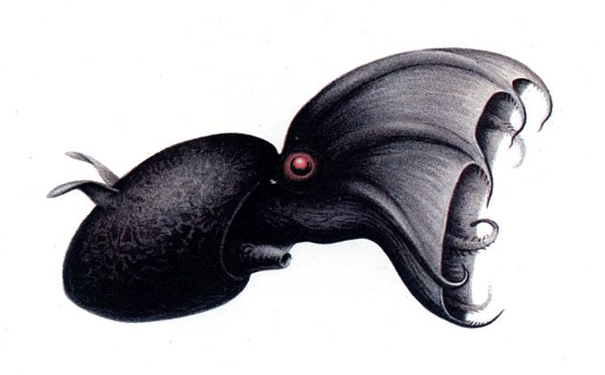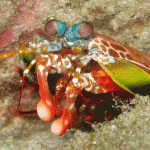
A Vampire Squid (Vampyroteuthis infernalis) drawn by Carl Chun, 1911
A trip to the Deep Oceans exhibition at the Australian Museum changed our perspective on these alleged neck nibblers.
The Vampire Squid (Vampyroteuthis infernalis) looks like something that swam out of a late-night science fiction movie. The squid’s scientific name means ‘vampire squid from hell’ because the webbing between its tentacles looks like a vampire’s cloak. However, despite its monstrous name and appearance, it is a small creature, growing to a maximum of 15 centimetres.
Vampire Squid are found throughout the deep oceans at depths from about 90 metres to over 900 metres. They have light-producing organs called photophores all over their bodies, with particularly bright ones at the tips of their tentacles. This chemical process is known as bioluminescence, and is common in many deep-sea creatures.
When threatened, a Vampire Squid performs the ‘pineapple’ move. It lifts its tentacles to wrap the cloak around its head, forming a ball with its sensory fingers facing outwards. If this doesn’t help, the squid squirts sticky, glowing mucus from the tips of its arms. This can stay lit up for up to 10 minutes, dazzling the predator while the Vampire Squid disappears into the shadows.
What look like ears are actually flap-like fins, which it uses to steer as it pulses through the water. The Vampire Squid is an ancient species that has elements in common with both squid and octopuses. In fact, when first seen in 1903, it was mistakenly identified as an octopus.
As with most deep-sea creatures, very little is known about the habits of the Vampire Squid. However, its diet is believed to consist of prawns, copepods, cnidarians and other small invertebrates, rather than the blood of unsuspecting humans.
If you’d like to know more about the Deep Oceans exhibition at the Australian Museum, click here. And don’t forget to check out our latest issue, where you’ll find an amazing gallery of deep-sea creatures.






